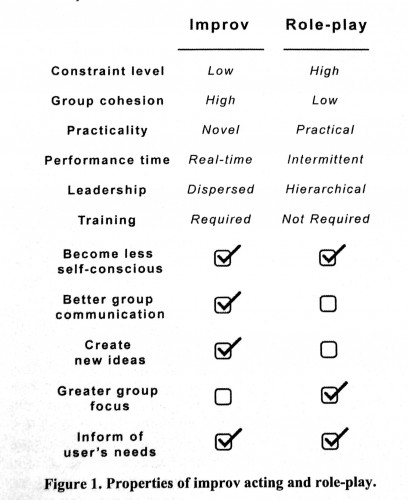Original:
Medler, B. Magerko, B. (2010). The Implications of Improvisational Acting and Role- Playing on Design Methodologies. CHI 2010: Dance, Dust, and Drama: Designing Design, p. 483-492
Authors:
Ben Medler, Brian Magerko;
Georgia Institute of Technology, 686 Cherty St, Atlanta, GA 30332
Keywords:
Improvisation, Role-playing, Design Methodologies, Performance, Theatre
Summary: The authors of this paper are making an effort to define and differentiate Improvisational Theater and Role- Playing as design tools and methods that support certain goal achievement such as:building self- confindence, creating new ideas, increasing group focus, informing of user´s needs, evaluating products and design ideas.
Main Contents:
Here you can write a little bit more about the core information of the paper. E.g. definition or description of specific terms, or list design guidelines & explain them shortly, or a give more detailed information about the technologies used, or decribe which evaluation methods have been applied … You can add pictures with references. But don’t write to much, not everything is important for us. Keep in mind to just give the essence here in 250 to 300 words.
Performance techniques to enhance the design process – Definitions
Improvisation:
– in jazz, theatre, organizational science, management, etc.
– unscripted performance
– flexible, original, error prone
– happens in real time
– major factors: group coherence, novelty, speed of execution and lack of planning
– not completely prescribed in terms of functional and/or content constraints
–> to break out of normal or common ways of thinking
–> a form of brainstorming
–> to create novel, interesting experience for an audience
–> to create mental models: cognitive consensus (Improvisers will predict, or infer, where other improvisers are heading in the story)
–> discovering what is hidden within a scene
–> building character/ relationships during performance
–> work collectively; as a cohesive group
=> is best acted out by trained improvisers; it requires little constrains and will help designers to obtain innovative, novel ideas. The outcome is not predictable which helps on getting new ideas that were not thought of before.
Role- Playing:
– for entertainment, training, psychological treatment
– interaction of players in virtual spaces/ imaginary world
– to become another person/ take on a character role in a constructed scene
– allows for the “infinite manipulation of time and space”
– not for an audience
– lead by Game Master/ leader – as director and facilitator (rules are followed and to move the story along)
–> view from another person´s perspective
–> creates realism, simulates a ‘real life’ episode or experience – under controlled conditions
–> leader: maintain group focus, influences direction and outcome
=> used best by designers and testers to focus on specific areas in the further developed design process. It will obtain more practical, efficient designs and insights – not so much innovation, because of the tight constrains.

A combination of these two techniques is the ‘Wizard of Oz’ method:
This technique allows designers to have control over user testing while still giving participants the freedom to improvise their actions:
– participants don´t know that someone is guiding their experience
– users are set in low-fidelity, mixed-reality environment with freedom to perform “daily routines
– designers trigger different events or constrain the user in different ways in real-time .
Ideas for costume evaluation:
Improvisation and Role- Playing are methods suitable for this project. Unfortunatley at the first design acting workshop we participated, our ideas/ storytelling were not developed enough to work with. Improvisation would have been a good design tool to create story and costume ideas. Although trained actors are necessary to achieve useable results.
Bodystorming, is also mentioned in the paper – we tried that with good results: Group coherence towards our costume ideas were achieved.
